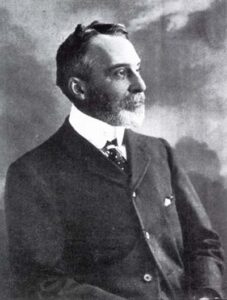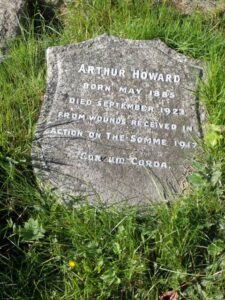Category: Military
Rank: Lieutenant
Regiment or Ship: 17th Bn Royal Fusilliers
Date of Birth: 25.05.1885
Place of Birth: Tunbridge Wells
Date of Death: 11.09.1923
Place of Death: St. Wilfed’s Lodge, Bexhill.
Place of Burial / Memorials:
Buried in St. Mark’s Church grave yard, Little Common. His gravestone claims he died from wounds he received during the Battle of the Somme in 1917.
Address: Birchington Estate & 43 Cantelupe Road, Bexhill
Photos and newspaper articles
Click on any image to see a larger version
Family Information
Father: Ebenezer Howard b.1850 in Nova Scotia, Canada. He died 20.10.1930 in Middlesex. In 1902 he became the first Mayor of Bexhill. Ebenezer is often confused with Sir Ebenezer Howard who developed the Garden City concept. They are not the same man.
Mother: Mary Grace Howard b.1857 in Clapham. They married in 1880 in Hastings. She died 05.04.1943 in Hove. She left all her money to her daughter Mary, a sum of £1477 8s 11d.
Siblings:
Ebenezer Cecil b.1881 Tunbridge Wells. Married Evangeline Bohn in 1906 Battle. When Evangeline died in 1953 she left her money to Pamela Heijbrock, Arthur’s daughter.
Mary b.1882 Tunbridge Wells
Geoffrey b.1890 Paddington.
There was another child but it did not survive and no further details have been found.
Wife: Betty Chune Fletcher b.1888 Holborn. They married in Holborn in 1910. Her father was eminent physician Dr. George Alfred Chune Fletcher.
Daughter: Pamela b.1911 Paddington. Married Marinus Henry Heijbrock in 1947. She was just 12 years old when her father (Arthur) died.
First World War Experience
Arthur Howard’s gravestone in St. Mark’s Church graveyard Little Common, states he “died from wounds received in action at the Somme 1917”. He didn’t actually die until September 1923, too late for inclusion on the town war memorial and to be considered an official war death. Nothing more was known about him until he was researched by the Museum.
During the First World War he was a Lieutenant in the 17th Royal Fusiliers. According to the battalion’s war diary they were employed on pioneer duties digging out, cleaning and pumping out trenches, fitting duck-boards and generally preparing trenches for future operations, often following previous battles.
On 16th March 1917 Arthur was wounded. As he was not involved with front line fighting it is most likely he was injured by a shell. He was awarded a Silver War Badge which was given to men who were honourably discharged through wounds. It was to be worn with civilian clothes and identified the wearer as a wounded soldier and not someone who had “shirked” his responsibilities. He was finally discharged in 1919 which suggests he had been hospitalised since March 1917 indicating very serious wounds.
Although it is not clear what his injuries were, a letter printed in The Times newspaper on 11th June 1921 does off one possibility. An Arthur Howard writes to complain of being refused entry to Lord’s Cricket Ground to watch a Test Match because he and a friend, both wounded during the War, were in wheelchairs. If this is the same Arthur Howard, then it is likely his injuries were to his legs, possibly losing one or both completely.
He finally died of his wounds at St. Wilfred’s Lodge, in Bexhill in 1923.
Additional Information
Arthur’s father, Ebenezer Howard, became the first Mayor of Bexhill in 1902. The family lived both in Paddington, London and in Bexhill at Birchington House on the Birchington Estate which Ebenezer had inherited in 1880. Birchington House was later enlarged to become St. Wilfred’s School, and was rebuilt following a fire in 1925 becoming Falconbury School.
These are extracts from articles about Ebenezer Howard written by local historian Bartley:
“…wrote to Mr Ebenezer Howard, of Birchington House, Little Common, asking him to see some representatives from Bexhill on ‘a matter of public importance’.
Mr Howard’s family link with Bexhill dated back to 1860 when his uncle bought Birchington Farm. After his death in 1880 Mr Howard, as one of his trustees, made several visits to the property, of which Mr William Duke was the tenant, and he was so attracted to the locality that in 1900 Mr William Gillham built him a small house on the south side of Collington Lane as a summer residence and adjoining which he laid out the cricket ground which became the scene of many memorable matches and festival weeks. After Mr Howard’s departure from Bexhill Birchington House was enlarged to become St Wilfrid’s School and re-built after the fire of 1925, subsequently became Bicton Place and is now Falconbury School.The deputation from Bexhill waited on Mr Howard at his home in Inverness Terrace, West London, and no one was more surprised than he to find that the object of the visit was to invite him to become the first mayor of Bexhill. Many years later Mr Howard disclosed that his name had first been suggested by the then Editor of the Bexhill-on-Sea Observer, Mr Fred Wilson. Mr Howard, who had never taken any part in local affairs nor intimated any wish to do so, eventually consented to be nominated and the deputation returned home well pleased. They were justified; they had done better than they knew.”
Bartley Article 174
“1902-03: Ebenezer Howard.- As the borough’s first mayor Mr Howard set a high standard and his conduct of affairs and firm chairmanship were of the greatest value. Although the manner of the invitation to him caused temporary controversy, the election of one who was dissociated from the feuds of the day was a wise move. He declined a second year of office, and although induced to stand for St Mark’s ward for which he was elected, he was one of those who resigned after the ratepayers’ rejection of the Town Bill of 1904 and thereafter took no part in public life. This was a sad loss, but his great service to the town was never forgotten by his contemporaries, and when he died in October 1930 the tribute was paid that he ‘proved himself a veritable king in Israel, towering head and shoulders over the people who he led to break the last shackles of feudalism and guided into the paths of social peace and good government’.”
Arthur was educated at Highfield and Melvill House Haileybury and went to Christ Church College in 1904.
When he died he left his wife Betty and his younger brother Geoffrey £2051 12s 8d.


